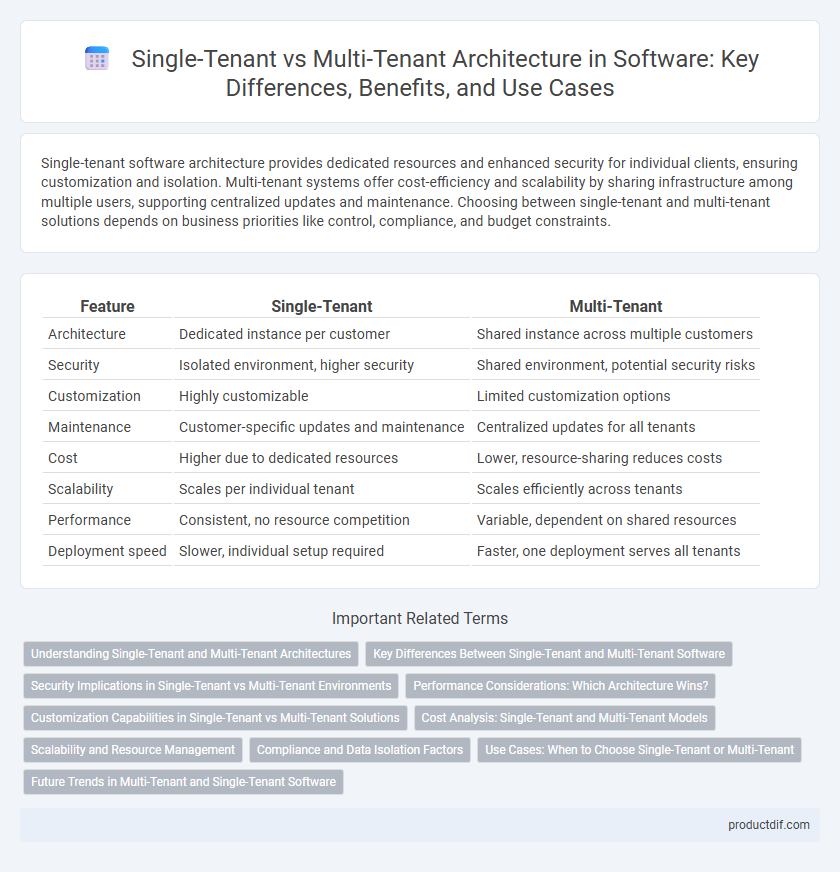Single-tenant software architecture provides dedicated resources and enhanced security for individual clients, ensuring customization and isolation. Multi-tenant systems offer cost-efficiency and scalability by sharing infrastructure among multiple users, supporting centralized updates and maintenance. Choosing between single-tenant and multi-tenant solutions depends on business priorities like control, compliance, and budget constraints.
Table of Comparison
| Feature | Single-Tenant | Multi-Tenant |
|---|---|---|
| Architecture | Dedicated instance per customer | Shared instance across multiple customers |
| Security | Isolated environment, higher security | Shared environment, potential security risks |
| Customization | Highly customizable | Limited customization options |
| Maintenance | Customer-specific updates and maintenance | Centralized updates for all tenants |
| Cost | Higher due to dedicated resources | Lower, resource-sharing reduces costs |
| Scalability | Scales per individual tenant | Scales efficiently across tenants |
| Performance | Consistent, no resource competition | Variable, dependent on shared resources |
| Deployment speed | Slower, individual setup required | Faster, one deployment serves all tenants |
Understanding Single-Tenant and Multi-Tenant Architectures
Single-tenant architecture provides dedicated resources and isolated environments for each customer, enhancing security, customization, and control over software applications. Multi-tenant architecture hosts multiple customers on a shared infrastructure, optimizing resource utilization, scalability, and cost-efficiency by serving several tenants from a single instance. Understanding these architectures helps businesses choose between tailored customization with higher costs or shared resources with improved scalability.
Key Differences Between Single-Tenant and Multi-Tenant Software
Single-tenant software dedicates one instance per customer, ensuring higher customization, dedicated resources, and enhanced security controls tailored to individual needs. Multi-tenant software hosts multiple customers on a shared infrastructure, optimizing resource efficiency, reducing costs, and enabling faster updates through centralized maintenance. The key differences emphasize resource allocation, scalability, cost implications, and customization flexibility, affecting organizational IT strategies and compliance requirements.
Security Implications in Single-Tenant vs Multi-Tenant Environments
Single-tenant environments provide enhanced security through isolated data storage and dedicated resources, reducing risks of data leakage between clients. Multi-tenant architectures require robust tenant isolation mechanisms such as containerization and strict access controls to prevent unauthorized data access. Compliance with industry standards like GDPR and HIPAA demands tailored security strategies depending on whether the software is single-tenant or multi-tenant.
Performance Considerations: Which Architecture Wins?
Single-tenant architecture offers dedicated resources that ensure consistent performance and lower risk of latency, making it ideal for applications requiring high processing power and predictable workloads. Multi-tenant systems share resources among multiple users, which can lead to variable performance during peak usage but benefit from cost efficiency and easier scalability. Performance optimization depends on workload intensity, with single-tenant excelling in high-demand environments while multi-tenant suits variable or growing user bases.
Customization Capabilities in Single-Tenant vs Multi-Tenant Solutions
Single-tenant solutions offer extensive customization capabilities, enabling businesses to tailor software features, workflows, and integrations according to specific needs without impacting other users. Multi-tenant architectures support limited customization, typically confined to user interface preferences and configurable settings, due to shared resources and uniform codebases. The depth of customization in single-tenant environments makes them ideal for enterprises requiring unique functionality or compliance with strict industry standards.
Cost Analysis: Single-Tenant and Multi-Tenant Models
Single-tenant software models typically incur higher upfront costs due to dedicated infrastructure and individualized maintenance, while multi-tenant architectures offer cost efficiency through shared resources and streamlined updates. Operational expenses for single-tenant setups often escalate with bespoke customization and scaling demands, whereas multi-tenant solutions benefit from economies of scale and centralized management. Analyzing total cost of ownership reveals that multi-tenant models provide scalable affordability, making them suitable for businesses prioritizing budget optimization without sacrificing service quality.
Scalability and Resource Management
Single-tenant architectures offer dedicated resources for each client, enabling easier scalability by isolating workloads but often requiring higher infrastructure costs and manual resource management. Multi-tenant environments optimize resource allocation through shared infrastructure, enhancing scalability with automated load balancing and dynamic resource distribution, which reduces operational expenses. Efficiently managing resource contention in multi-tenant systems is critical to maintain performance, especially as user demand scales in cloud-based software solutions.
Compliance and Data Isolation Factors
Single-tenant software architecture ensures complete data isolation by hosting one client per instance, making it easier to achieve stringent compliance requirements such as HIPAA, GDPR, and SOC 2 due to dedicated environments and customizable security protocols. Multi-tenant systems share infrastructure and resources across multiple clients, posing challenges for data segregation but often implement robust logical isolation methods and encryption to meet regulatory standards. Compliance audits in single-tenant environments benefit from clearer data boundaries, while multi-tenant solutions require advanced monitoring and tenant-specific access controls to mitigate cross-tenant data risks.
Use Cases: When to Choose Single-Tenant or Multi-Tenant
Single-tenant architecture best suits organizations requiring enhanced security, extensive customization, and strict compliance, such as healthcare and banking industries. Multi-tenant systems offer scalability and cost-efficiency ideal for startups and businesses with standard software needs looking for rapid deployment. Choosing between single-tenant and multi-tenant depends on factors like budget, data isolation requirements, and integration complexity.
Future Trends in Multi-Tenant and Single-Tenant Software
Future trends in multi-tenant software emphasize enhanced scalability, advanced data isolation techniques, and increased integration of AI-driven analytics to optimize resource allocation across tenants. Single-tenant architectures are evolving with stronger security protocols, customizable compliance frameworks, and greater control over data sovereignty to meet industry-specific regulations. Hybrid models combining the flexibility of multi-tenant environments with the privacy benefits of single-tenant deployments are gaining traction, driven by demand for optimized performance and cost-efficiency.
Single-Tenant vs Multi-Tenant Infographic

 productdif.com
productdif.com